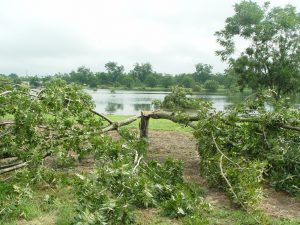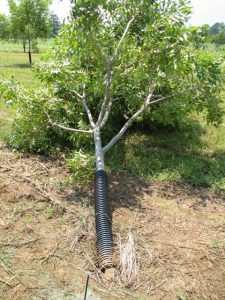Hurricane/Tropical Storm Hermine passed through Georgia last week causing serious damage to portions of the pecan growing region but overall most growers are thankful the damage was no worse. The most severe damage reflects the path of the storm and as usual was much worse on the right side of the storm’s center. This placed the worst damage on a line including but not limited to Thomas County up through Brooks, Colquitt, Cook, Lowndes, Berrien, into Ware, Pierce, and up into Screven Counties. Anything roughly along this path suffered worse in general than those areas further North and West. Growers from the worst hit regions report many trees blown down or twisted and broken, large limbs broken, and approximately 30% of the nuts blown or shaken off the trees by the winds. Most of the trees blown down were in the 15 year or younger range. While all areas overlaid by the storm throughout the state had some trees down and nuts blown or shaken off the trees to various extent, on a whole, the damage was far less than along the line referenced above.
Growers with downed trees should consider the following as they clean up the damage:
Attempts to save uprooted trees are generally unsuccessful. Trees completely uprooted or blown to the ground should probably not be righted, because of poor survival. If trees are 10–12 years old or younger, or have trunks less than ≈12 inches in diameter, survival rate is usually much better. There is also greater likelihood of recovery from uprooting if the soil is extremely wet when the trees blow down and major roots are unbroken. If major roots are broken, these trees sometimes survive, but they are usually not thrifty and easily uprooted again. Pruning such trees back could aid in their survival.
Experience with these storms indicates that small trees should be righted quickly, before roots exposed to the air are killed. Righting of trees should be done when the soil is wet to prevent further root injury. Such trees will usually remain productive, especially if the canopy is pruned back to balance the loss of roots. Hurricanes and tropical storms often cause trees to lean at various angles. The roots of leaning trees may or may not be pulled out of the ground, but often have sustained some injury. Long-term survival of leaning trees is unpredictable. Some Trees blown over to ≈45° angles have remained productive for at least 20 years without straightening. Still, other trees leaning at small angles died a few years later. Straightening of leaning trees after the tree is dormant tends to be effective only with small trees (i.e., trunks less than ≈12″ diameter). Again, wet soil conditions facilitate survival. Straightened trees usually require support from frames or wires. Subsequent nut yields from such trees are usually good if tree vigor is not noticeably diminished.
The basics of USDA’s Tree Assistance Program (TAP) can be found at the following link:
FSA also runs another program which can be used for clean-up after storms on a farm called the Emergency Conservation Program (ECP). The ECP will help pay for the cost to clean up debris from a natural disaster. Pecan trees damaged or uprooted from a storm could be eligible for cost-share assistance provided the area gets the ECP program implemented. The local FSA Committee must request the program and then a sign-up program is announced.
It is important that clean-up does not start until it has been inspected by an FSA employee. Cost-sharing is based on the number and age (size) of the trees. Information on ECP is found below:
https://www.apfo.usda.gov/FSA/webapp?area=home&subject=copr&topic=ecp
For both the TAP and ECP programs, growers need to contact their local FSA office and have the FSA employee inspect the property then proceed with the appropriate paperwork on TAP and follow the process/timeline for the ECP.


